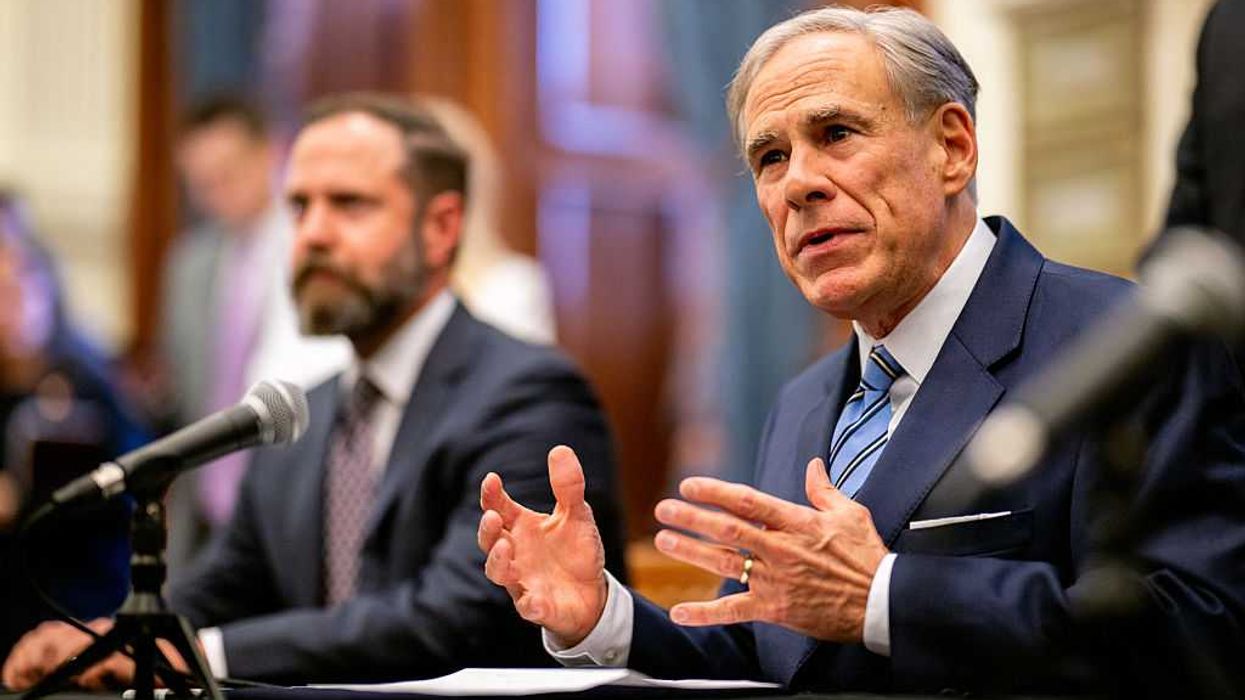Earlier this week, Glenn told audiences about the undersheriff in Colorado who claimed that the Department of Homeland Security was teaching police in his state to look at Christians who interpret The Bible literally, believe America was founded on Godly principles, or are "fundamentalists" as potential members of the sovereign citizen movement. Today, Glenn interviewed that undersheriff, Ron Trowbridge, about exactly what he saw during the training session and why he decided to speak up.
Transcript of the interview is below:
GLENN: Okay. I want to go to Prowers County, the Colorado undersheriff Ron Trowbridge. Last Monday he attended a Colorado State Patrol training session and they were warned by the State police to watch out for sovereign citizens and Christians who take the Bible literally or say that America was founded on Godly principles, and fundamentalists because they're trouble.
Ron is with us now. I'm sure this caused a firestorm in Colorado. Again, the undersheriff from Prower County ‑‑ Prowers County, Colorado. Welcome to the program, Ron.
TROWBRIDGE: Thank you, Mr. Beck.
GLENN: Thank you. First of all, thank you for having the guts to actually expose this. Because I have to believe at some point you thought that yourself or maybe you talked to your wife and said, "This could turn out ugly for me; do I say anything."
TROWBRIDGE: Yeah, I did. You know, it offended me greatly at the time. It took me back so much, I just ‑‑ I just went back to the office right away. I regret that I should have said something there at the time, but it stuck with me, it stewed with me and ‑‑ but I ‑‑ you know, I teach to my kids, I teach to our people that we're to do the right thing no matter what the cost, and I think this is the right thing. I think they need to know.
GLENN: Okay. So here is the statement from the Colorado State control: Law enforcement training class offered by a Colorado State control April 1st, Southeastern Colorado has come under scrutiny from one of its attendees, blah, blah‑blah. Baker, the guy who was teaching it, Baker's statement went on to note that the officials had spoken with several officers who attended the same training ‑‑ I'm sorry. It was not Baker. This is ‑‑ Baker is the ‑‑
TROWBRIDGE: Kluczynski.
GLENN: Yeah, and Baker is the guy who was the Colorado State patrol sergeant that released this thing.
Baker's statement went on to note that officials had spoken with several officers ‑‑ I'm quoting ‑‑ who attended the same training and they did not interpret the comments delivered by Kluczynski in the same manor as the undersheriff. We regret that he misinterpreted the training material in a way that is clearly not the position of the Colorado State Patrol.
TROWBRIDGE: Well, I don't know how you misinterpret those who believe the country was established on Godly principles, those who believe the Bible is literal, those who take it too serious, I don't know how you misinterpret that. I am one of those people.
GLENN: Okay.
PAT: And that was the statement was that he said that those who interpret the Bible literally are dangerous, are extremists or ‑‑
TROWBRIDGE: Well, you know, he didn't say "dangerous." What he was trying to do was show that, hey, these people tend to gravitate towards this sovereign citizen movement and they're potentially ‑‑
GLENN: Tell me what a sovereign ‑‑ tell me what a sovereign citizen is.
TROWBRIDGE: Well, there's no direct definition for them, but generally they're people who, they like to dodge their responsibility for debt, for ‑‑ they don't pay taxes, they don't recognize laws when it concerns them. They often use the court system to bully those who stand in their way.
GLENN: Extraordinarily anti‑police as well.
TROWBRIDGE: Oh, absolutely, yes.
GLENN: Right. Stu, correct me if I'm wrong, but the sovereign citizen is the movement that I came out, this was right maybe even before the Occupy Wall Street and I said this movement is going to happen from the left and here, look at this movement because this is extraordinarily anti‑police. And weren't they saying that they were going to build bombs and blow up police stations?
STU: Yeah, you're talking about a specific militia group ‑‑
GLENN: I think it ‑‑
STU: ‑‑ that was related to this, yeah. But that's correct.
GLENN: Okay. So now he's talking about this and this group is a threat and ‑‑
TROWBRIDGE: Yes.
GLENN: And so he's talking about this and so then how did he get from those guys to Christians?
TROWBRIDGE: Well, see, he ‑‑ he never really described those guys and that's what angered me so much. I get the point that many people hide behind the banner of Christianity while they preach anything but Christianity. And had he explained that clearly, well, yeah, no problem. But he never really got there. He explained it as simply, just as I described, those people who take the Bible literally. He never really went into any depth on it.
GLENN: All right. So I take the Bible literally as well. Are you, are you telling me then that he said that they were sovereign citizens or they should be watched, or how, what ‑‑
TROWBRIDGE: Well, he wasn't saying that they were necessarily sovereign citizens, although several of the people kind of laughed about that saying, "Yeah, I guess I'm a sovereign citizen then." But what he was saying was that these people have leanings towards sovereign citizen ideology. And he described it as, you know, a chunk of icebergs is what I'm trying to think of in the ocean and the big portion of it is underwater and that's where these groups tend to be. They're kind of, they're legal, and he emphasized that they have the right to their opinion, but that when something ‑‑ something may happen that might spur them on to illegal behavior.
GLENN: Okay.
TROWBRIDGE: And so he kind of lumped us all together.
GLENN: You talked to ‑‑ when you released this, what has the blowback been? What's happened since?
TROWBRIDGE: Well, you know, I've ‑‑ I got a lot of support from several people around the country, and I certainly appreciated that. I don't mind telling you I'm scared to death and ‑‑ not for myself but ‑‑ I'm not worried, but really about, did I do the right thing or not. And I spent many sleepless nights wondering about that. I ‑‑
GLENN: Why do you question it?
TROWBRIDGE: Well, you know, because unfortunately there are those who took that opportunity, who took my statements to make threats and attack the troopers at the state patrol. And I think that was wrong because they're good people. They ‑‑ many of them believe just like I do. They've got a tough job to do and they're trying to do it and ‑‑
GLENN: Well, I don't think this is about anybody ‑‑
TROWBRIDGE: ‑‑ they don't deserve that.
GLENN: Maybe I'm the only one that read it this way, Ron, but I think this is only about the guy who made that statement, and he's leaving the State Patrol to go to the Department of Homeland Security.
TROWBRIDGE: That's the way intended it to be.
GLENN: Right. And that's the way I at least read it. I mean, am I alone in that? I don't see this as something against the state troopers. I see this as a guy who is packing his bags. I mean, isn't he ‑‑ is he now no longer part of the state patrol?
TROWBRIDGE: Yeah, he said at the class. He at the beginning of the class he said, I'm going to the Homeland ‑‑ Department of Homeland Security. Friday is his last day and this is his last hoorah.
GLENN: So your sheriffs have kind of rallied around you, have they not?
TROWBRIDGE: Yes, he has. The sheriff's been very supportive.
GLENN: But I mean the sheriffs around Colorado, in Colorado, have they not all kind of ‑‑ isn't there a group of you that are kind of standing together?
TROWBRIDGE: Well, I don't know. I think that's probably too strong of a statement.
GLENN: Okay.
TROWBRIDGE: I think they're not sure about my stand or why I'm making the stand. I think that's why so many in that class, why they just don't get it, why ‑‑ what I'm bothered about, why this upset me. So there have been some who have called and the sheriff spoke to them. I did ‑‑ I spoke to one and he seemed supportive but I can't really say that for sure.
GLENN: I have to tell you, Ron, there's a lot of people that would say things like this and try to become famous or they try to have their, you know, their five minutes of fame or they would try to become more powerful or anything else. I sense from you that you are an extremely reflective man, a decent man who, you are reluctantly saying this, you feel compelled to say it. I think that's honorable, Ron. Have you heard from any of the state control?
TROWBRIDGE: Yes, I have. I spoke to Major Copley. I've known Major Copley for several years. He tried to reassure me that the way I took the class was not the way it was intended to be taught.
GLENN: See, I got a problem with this. I mean, I'm sure you know him, and I'm not saying ‑‑ I am a huge supporter of our police, I am a huge supporter of our state patrol. I have been ‑‑ when Pat and I worked together 30 years ago in Baltimore, Maryland when they were just shooting at the state patrol on the highways as they ‑‑ I mean, it was bad. I have been a ‑‑ I would never want to do any of your jobs and I have tremendous respect for you. With that being ‑‑
TROWBRIDGE: Well, I've got to tell you I would rather go into a big bar fight than deal with this again.
GLENN: Well, I know. I will tell you that ‑‑ and that's what they want you to learn, by the way, Ron. I will tell you that what bothers me about this is it's one thing to say, you know, "Well, I'm sorry for the misinterpretation" because that's not really ‑‑ I mean, if he said those things, what they should have said is, "That's not our policy." If, you know, "We've discussed it with him and he said that wasn't his meaning, we're sorry for the misinterpretation but we want to make it extraordinarily clear we disagree with those things," and I ‑‑ I guess I kind of see this. You know, "We regret that he misrepresented the training material in a way that clearly is not the position of the Colorado State patrol." Are they talking about you, or are they talking about Kluczynski on that line? Do you know?
TROWBRIDGE: Well, I'm not sure about that. Other statements, of course, are that nobody else in the class took it the way I took it and so I tend to believe they're referring to me on that.
GLENN: Do you know if anybody else took it that way? I'm not asking for names or any ‑‑ pardon me? You didn't talk to anybody else?
TROWBRIDGE: I'm sorry? I ‑‑ you know, I have not talked to them about it really and, you know, I'll make my stand where I need to make it. I think that assume look at it as a battle not worth fighting. Some, I think many look at that as ‑‑ and think that, "You know what? I don't see the problem with it." So I think that I probably stand alone in the group.
GLENN: Ron, when you're you standing up for the truth, there is nothing that at the end of the day is more honorable than standing alone, and I congratulate you for it and I wish you well, and we will keep you in our prayers as we will all of the sheriffs around the country, all the state control and all the police as well as we head into turbulent times in our nation. God bless you.
TROWBRIDGE: Thank you.
GLENN: Thank you very much.
This is the kind of guy who is ‑‑ we need more of. I wish I would have handled my career that way for a longer period of time.

 Harold M. Lambert / Contributor | Getty Images
Harold M. Lambert / Contributor | Getty Images
 Adam Gray / Stringer | Getty Images
Adam Gray / Stringer | Getty Images Anadolu / Contributor | Getty Images
Anadolu / Contributor | Getty Images Brandon Bell / Staff | Getty Images
Brandon Bell / Staff | Getty Images